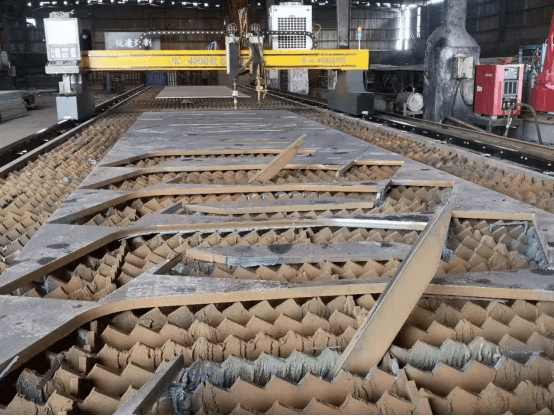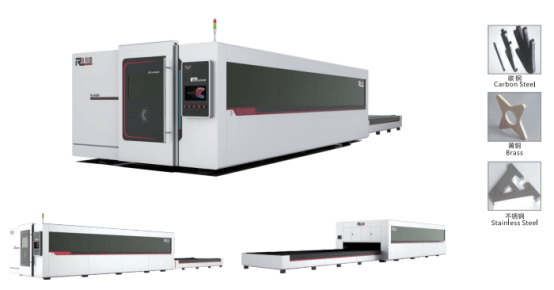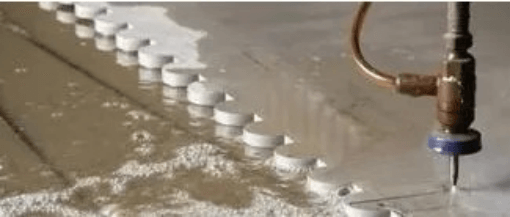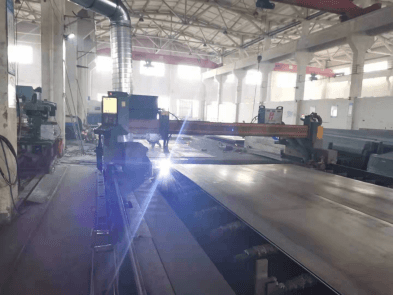Oxygen-gas, plasma, laser or water jet
There are many ways to cut carbon steel plates with oxygen-gas, plasma, laser or water jet, some of which are suitable for automatic cutting, and some are not suitable. Some are suitable for cutting thin plates, and some are suitable for cutting thick plates. Some cutting speed is fast, some cutting speed is slow. At the same time, the cost of equipment and the cost of use, and the accuracy of cutting are also aspects that need to be considered.
This article will briefly introduce the four cutting methods used on CNC cutting machines, compare the advantages and disadvantages of various processes, and provide some standards that can be used to determine which cutting method is most suitable for your application.
Oxygen-fuel cutting

Oxygen-gas torch cutting or flame cutting is by far the longest cutting process used to cut carbon steel. The equipment and consumables used are relatively inexpensive. The oxygen-fuel cutting torch can cut very thick steel plates, mainly limited by the amount of oxygen that can be delivered. The case of using an oxygen-gas cutting torch to cut 100mm or 200mm steel plates requires a large flow of oxygen supply. However, as far as steel plate cutting is concerned, most of the cutting is concentrated on steel plate within 30mm thickness. After proper adjustment, the oxygen-gas cutting torch can achieve a smooth surface for vertical cutting. There is almost no slag on the lower edge, and the top edge is slightly rounded only because of the preheating flame. Such a cut surface is very suitable for most applications that do not require further processing. At present, oxygen-gas cutting is mostly used to cut steel plates with a thickness of more than 30mm, but it can also be applied to cutting medium and thin plates. Flame cutting is relatively slow, up to about 500mm/s per minute on a 25mm material. Another advantage of oxy-fuel cutting is that multiple torches can be used for easy cutting at the same time, thereby improving production efficiency.
Plasma cutting

Plasma cutting is an ideal process for cutting carbon steel plates. Its cutting speed is much higher than that of oxygen-gas cutting, but at the expense of some edge quality. The thickness of the plate cut by plasma is usually between about 6mm and 40mm. Generally speaking, when the steel plate is very thin or thick (beyond the range mentioned above), although the edge smoothness and slagging performance may still be quite good, the edge verticality will begin to suffer.
Compared with oxygen-gas cutting torch, plasma equipment is more expensive, because a complete system requires power supply, water cooler (used for systems exceeding about 100A), gas control device, cutting torch wire, connecting hoses & cables, and cutting Torch itself. However, the increased productivity of plasma relative to oxygen-fuel gas will soon be able to compensate for the cost of the system.
Multiple torches can be used to perform plasma cutting at the same time, but the additional cost usually makes customers only configure two torches. Of course, some customers do choose to configure as many as three or four plasma systems on one machine, but these customers are usually high-end manufacturers who cut a large number of the same parts to meet the needs of the production line.
laser cutting

The laser cutting process is suitable for cutting medium carbon steel from the smallest thickness to about 30mm. Beyond the range of 25mm, all factors such as material (laser grade steel), gas purity, nozzle conditions and laser beam quality must be correct to achieve reliable cutting.
The speed of the laser process is not very fast, because fundamentally speaking, the laser is only a processing process that uses a focused laser beam (not a preheating flame) to apply extreme high temperatures to the cutting material. Therefore, its speed is limited by the speed of the chemical reaction between iron and oxygen. However, the precision of the laser process is extremely high. Since a very narrow incision width can be formed, contours and small holes with high precision can be cut. The edge quality is usually quite ideal, with very small fine teeth and delay lines, very square edges and little or no dross.
Another big advantage of laser technology is reliability. Consumables have a very long life and a high degree of mechanical automation, so many laser cutting operations can be performed in an "unattended" state. Just imagine, put a whole steel plate on the workbench, press the "start" button, and when you come back, there will be hundreds of parts cut, waiting to be unloaded.
In view of the complexity of beam transmission, CO2 laser is not suitable for multi-head cutting on the same machine. However, fiber lasers can perform multi-head cutting.
Water jet cutting

Water jet cutting can also cut medium carbon steel well, and can achieve smooth and high-precision cutting results. The accuracy of water jet cutting is higher than that of laser cutting because of the better edge smoothness and no thermal deformation. In addition, the thickness limitation of water jet and laser and plasma cutting is different. The actual limit of water jet cutting is about 150 to 200 mm, based on the length of time to cut the thickness and the tendency of water flow to deviate.
The disadvantage of water jet cutting is the operating cost. Due to the high cost of booster pumps, the initial equipment cost is usually slightly higher than that of plasma cutting, but not as high as laser cutting. But mainly because the cost of the garnet abrasive for cutting is higher, the hourly cost of running the water jet is much higher.
In addition, water jet cutting is also suitable for multi-head cutting, and a single booster pump can even accomplish this job. But each additional cutting head requires an increase in water flow, which in turn requires a larger pump or a smaller orifice.

How to choose?
1. First consider the thickness:
Each cutting process is suitable for different cutting thicknesses, and it is necessary to select a suitable cutting method based on the comprehensive input cost and use cost.
2. Consider the accuracy and edge quality requirements:
Can you accept the edge quality of the plasma process? When using plasma cutting, the incision will inevitably have a certain slope.
Can oxygen-gas, plasma or laser heat-affected zones be accepted? The heat-affected zone of these three methods decreases successively. If there is no heat-affected zone, water jet cutting is used.
3. Consider which is more important: productivity or cost?
· If productivity is the most important, do not use water jets.
· If low initial investment and low operating costs are the most important, use oxygen-fuel gas
·
4.Tolerance of secondary processing:
· Can you tolerate occasional dross at the bottom of the steel plate? If not, use water jet or laser.
· Does the secondary machining need a perfectly round hole? If necessary, use water jets or lasers.
5. Multiple cutting torches
Is the part suitable for cutting with 2, 4 or more torches? Oxygen-fuel gas and plasma can use multiple cutting torches for cutting, but if the initial investment of all equipment is considered, the cost is relatively high. When using water jet, if the flow rate of the purchased pump is sufficient to support multiple cutting heads, a single booster pump can be used to run multiple water jet cutting nozzles. Although fiber lasers support simultaneous cutting with multiple heads, laser cutting is traditionally limited to the use of a single cutting head.
Summary
The thickness ranges and functions of these four processes overlap with each other, which makes it difficult to choose which process to use for any particular medium carbon steel part. Therefore, manufacturing plants that need to be able to cut multiple materials usually end up using machines equipped with at least two cutting processes. Sometimes, the only way to figure out which process is best for a particular part is to try many different ways to see which process works best.
Metal cutting selection equipment reference, one-stop supply of CNC plasma cutting machine and fiber laser cutting






